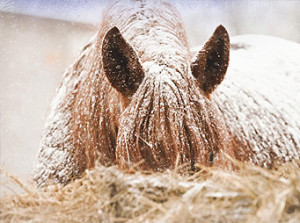Banish That Winter Coat – Top Pros Give Tips to Get a Great Hair Coat
Click here to read the complete article212 – January/February, 2018
by Delores Kuhlwein
 The young woman smiled as she put the final touches on her horse’s silky coat, her arms aching, but her heart full of pride. After months of preparation, her horse was ready for their much-awaited show. With a sigh, she closed the stall door and turned off the barn lights, ready for bed. The next morning, as she passed by her gelding’s stall, she stopped short and gasped out loud. Poof! Somehow, much to her chagrin, he had popped a fluffy hair coat, and it seemed to have happened overnight.
The young woman smiled as she put the final touches on her horse’s silky coat, her arms aching, but her heart full of pride. After months of preparation, her horse was ready for their much-awaited show. With a sigh, she closed the stall door and turned off the barn lights, ready for bed. The next morning, as she passed by her gelding’s stall, she stopped short and gasped out loud. Poof! Somehow, much to her chagrin, he had popped a fluffy hair coat, and it seemed to have happened overnight.
If this has ever happened to you, read on for advice from trainers who specialize in the discipline that seems to have perfected the science of horse hair coats. Halter horses are known for having the best hair coats in the business, and the legendary trainers who lead and fit them are a wealth of information. We spoke to Tim Finkenbinder, Ross Roark, and Ted Turner about their techniques and tricks of the trade to help them achieve the lustrous hair coats you see on their world champions.
Lights
One of the biggest mysteries surrounding a “tight” hair coat surrounds the rules of lighting. Although opinions vary, depending who you ask, the tried and true habits of Halter trainers have remarkable similarities.
“Lighting is one of the most important aspects, as well as consistency,” says Turner. “Our lighting comes on at 5:30 every morning, and it goes off at 10:30 every night. It never changes.”
“You need to simulate the long summer days,” explains Finkenbinder, whose lighting schedule is similar: 6 am to 10 pm. “The key is the length and the brightness of the light. The newer LEDs are excellent, and it’s what I use in my barn. Oldtimers used to tell me that you had to be able to read a newspaper, and then you’d know the light was the right brightness.”
Roark also keeps a 6 am to 10 pm schedule, and he uses a 200-watt bulb. He says it may take some horses longer to respond, but that persistence pays off. “If you have to upgrade your lights, do it,” he instructs. “If you stay on top of it, they’ll shed out that winter coat.” His philosophy has resulted in very few body clips over his history with horses, a record he seeks to maintain every year. “I’m not a fan of body clipping as I feel it negatively affects their hair for a long time.”
Click here to read the complete article212 – January/February, 2018










